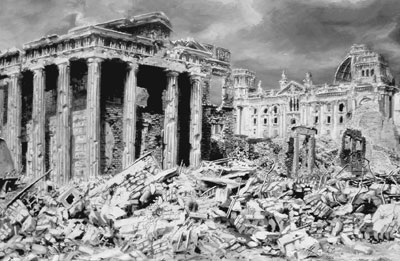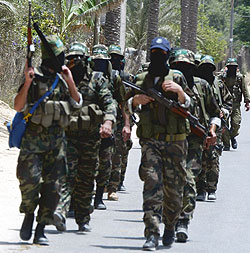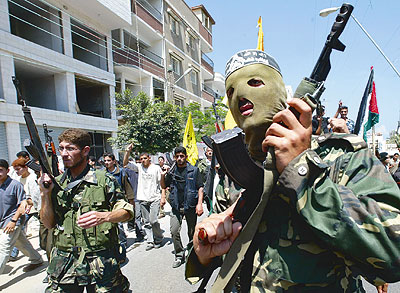 This information has been archived for reference or research purposes.
This information has been archived for reference or research purposes.
Archived Content
Information identified as archived on the Web is for reference, research or recordkeeping purposes. It has not been altered or updated after the date of archiving. Web pages that are archived on the Web are not subject to the Government of Canada Web Standards. As per the Communications Policy of the Government of Canada, you can request alternate formats on the "Contact Us" page.
Modern Warfare and Technological Development

KHM, Wien
David with the Head of Goliath, by Michelangelo Merisi da Caravaggio.
The End of Asymmetry: Force Disparity and the Aims of War
For more information on accessing this file, please visit our help page.
Asymmetry is no longer a useful concept in the analysis of 21st Century warfare. A more accurate analysis emerges from recognizing the fundamental disparity between opposing forces and the system implications of such a disparity in force. This in turn leads to a plausible redefinition of the structure and mission of the Canadian Forces (CF) abroad.
Introduction: The End of Asymmetry
Asymmetry is a concept commonly and mistakenly used in the analysis of 21st Century warfare, even though it is as old in human terms as conflict itself, and is therefore not unique to current situations. Like the biblical story of David and Goliath, ideally, combat has always been asymmetrical, for opposing forces tend to fight on equal terms only if battle cannot be avoided.
‘Symmetry’ and ‘asymmetry’ are the ends of a continuous spectrum that assumes a common measure between comparable things. Whatever the measure used, something is more or less symmetrical or asymmetrical when it is compared to something else. When the comparison is between apples and screwdrivers, or between oranges and circuit boards, however, there is little value in using asymmetry to describe their relation.
Because such comparative analyses of 21st Century warfare are not fruitful, in order to understand current and potential armed conflict better, asymmetry needs to be replaced with the systems concept of “force disparity.”
Force disparity is an absolute disjunction between the forces available to the opposing sides. It is not just difference in degree, but in kind. Force disparity in the context of 21st Century warfare recognizes that combatants may be so utterly different in terms of the nature and equipment of their respective militaries that nothing useful or meaningful is to be gained by a comparison of the two sides. Either the military forces are incommensurable – what value is there in comparing Hellfire missiles against pointed sticks? – or the disparity is so absolute that the two sides will never be fielding forces that are even remotely comparable in numbers, equipment or training.
Force disparity by itself is merely a descriptive term – stating what should be obvious to even the most casual observer. What is not so obvious, and what presents serious challenges for global peace in the 21st Century, are the system implications of force disparity. Force disparity entails a non-linear method of combat on both sides for the accomplishment of war aims, and emphasizes how, in a systems environment, individual actions can be leveraged to create disproportionate effects.
Force Disparity and the Aims of War
War aims are related to the means by which they can be achieved. In a conflict between two powers that can field an equivalent military force, war aims are likely to be complementary. One country may wish to acquire territory, another, to defend it. What makes the available forces comparable renders the war aims complementary. Even when there is a preponderance of force on one side (the inevitable asymmetries of combat), as long as there are comparable forces, war aims are complementary.
Force disparity in 21st Century warfare, however, creates two distinct phases of conflict in which the overall war aims of both sides change significantly between phases.
In the primary phase, the war aims of the dominant force are apt to be immediate, clear, straightforward and territorial (in a classic or traditional sense of warfare). For the realization of these war aims, the direct application of military force to specific objectives is required, and success is easily measured by how quickly these objectives are attained while minimizing friendly casualties and maximizing those of the enemy.
Once these primary aims are accomplished, the war aims in the secondary phase concentrate on maintenance, systems change and disengagement. Maintenance involves maintaining force disparity and, therefore, force security in a post-combat situation. Systems change involves changing, replacing or rebuilding the political, economic and social systems affected by primary phase conflict. Disengagement obviously is the end result of these operations, in which the intention of the primary phase force members is to do their jobs and go home as quickly as possible.
In the secondary phase of conflict, however, the dominant force will have fewer opportunities for the direct application of overwhelming force, and the benchmarks for evaluating success (such as the war aims themselves) are necessarily more ambiguous than in the primary phase.
If we then turn to the war aims of the inferior side in a situation of force disparity, the war aims are not complementary with those of the dominant force in either conflict phase. In the primary phase of conflict, conceding immediate and inevitable defeat, the war aim of the inferior side is to survive hostile contact with the maximum military capacity still intact, and to position itself for the secondary phase.
The secondary phase war aims of the inferior side, unlike those of the dominant side toward stability and disengagement, instead depend on engagement and escalation, with direct and focused hostile activity that is clear in terms of short-term objectives. Conflict involves the local application of force intended to leverage system effects dangerous to the dominant force. The absence of clear long-term goals in the secondary phase for the inferior side has no effect on the identification and prosecution of local targets.
For the inferior side, whether the conflict is religious in motivation – or political, economic or psychological – the ‘Cause’ is used to discount the significance of casualties regardless of their rate. Nor is the failure to achieve an end to hostilities something that by itself undermines the will to fight of the opposition – if the immediate secondary phase war aim is simply to hurt the invader, then (given the opportunities to lash out presented by multiple targets), it can be judged a success on a daily basis. Force disparity creates a situation in which the inferior side cannot lose – when the dominant side inflicts casualties, it is to be expected; when the inferior side inflicts casualties, it is a victory for the rebels.
While this is not a new phenomenon – after all, it could easily be described as classic guerrilla warfare – in the context of global economic, political and social systems – and thanks to the immediacy of electronic communications – local actions are undertaken primarily to leverage a variety of effects at a distance from the combat zone.
Such immediate secondary phase war aims, understood in terms of complex and interrelated systems, allow for the choice and use of leveraged weaponry – like box cutters on passenger jets – that have system effects far out of proportion to their initial impact.

CMJ collection
For many years, success in battle was often equated with an overwhelming application of force. Soviet shelling of Berlin, April 1945.
Force Disparity and the Weapons of War
The system effects of force disparity in 21st Century warfare require a reconsideration of the weapons of war and the dimensions of the battle space.
The conundrum posed by force disparity is that superior firepower may be the means of tactical victory, but may also guarantee longer-term, strategic defeat. To this point in history, the side with the technical advantage – whether the larger guns, longer pikes, faster chariots, better ships, more skilled sailors or whatever – has tended to gain ‘victory,’ but this is no longer the case.
Not only have the parameters of victory changed in both present and potential conflicts within global culture, but without a consideration of the ‘softer side’ of contemporary warfare, defeat may result from an inability to manage the system of conflict, especially if there is a fundamental force disparity in play. However spectacular the successes in the primary phase of conflict, defeat in the secondary phase (especially when the secondary phase war aims of the dominant force are ambiguous) results not from a shortage of force, but from its misapplication.
The misperception that superior firepower wins wars as well as battles is a consequence of a larger misperception common in Western culture that technology is ‘primarily about widgets.’ A different conclusion emerges from an understanding of technology as instrumental knowledge – knowledge used to a purpose. It is actually the knowledge, and the use to which the knowledge is put, that are of primary importance, not the tool itself. In the absence of certain widgets, the same goals may be accomplished by other means.
The realization that subtleties rather than firepower win secondary phase conflicts funda men tally changes the potential means by which war aims may be achieved, and even what war aims can be realized.
This is not merely a case of preferring ‘spin doctors’ to A-10s. The global economy presents a multitude of examples of how the manipulation of non-physical entities can lead to concrete consequences. Investor confidence, consumer behaviour, and public opinion are all ‘unreal,’ but changes in these things lead to real social, political and economic consequences.
For example, the psychology of all combatants is increasingly significant because warfare in the post-modern age inevitably involves whole populations, and the leveraging of effects translates a local defeat or victory into something that affects a much larger group of people.
For example, suicide bombings are intended, not to inflict damage or casualties in the first instance – unless as directed assassination – but to leverage their effects in a global political context. The primary force multiplier is the conveying of information to a larger public not as much at risk from the physical threat of future attacks as from the psychological implications of their future possibility.
Were there to be an absolute ban on reporting of the event – and especially of those claiming responsibility – and the determination not to allow changes in policy as a result of such acts – their frequency would not be reduced, but the leveraged effects would at least be minimized, if not eliminated. The reason these attacks are most frequently aimed at democratic societies is self-evident, given the apparent influence that public opinion and a free press has on decision-making by government or other entities.
The dominant side needs to use the system effects of force disparity to leverage positive effects in order to prevail in the secondary phase of conflict. Providing the inferior side with some tangible reasons for hope of a better future tempers the less rational dimensions of their secondary phase war aims, and permits the construction of some means of realizing that hoped-for future. Building schools, digging wells, or repairing roads and bridges are not merely humanitarian aid, as is often the representation, but are also pragmatic extensions of the dominant side’s combat superiority.
If improved living conditions soften the resolve of the inferior side, then to stay in the fight in secondary phase warfare, the ‘opposition’ must, paradoxically, deny such things to its own population under the guise of resisting the enemy. This tactic, in the longer term, must, of course, inevitably undermine the opposition’s popular support.

Worldnews photo af8dea1f6e46649507fadfebdf69e197

Worldnews photo 7266585dd3eeb3
The terrorist as a force multiplier – Hamas militants.
System Effects of Force Disparity
Force disparity needs to be recognized as a dominant dimension of conflict in the post-Cold War period. The successful resolution of conflict in the 21st Century requires a much more sophisticated response than merely an increased investment in new and more sophisticated primary phase military hardware. In fact, such an investment of scarce resources means they are therefore denied to other initiatives in which they could be used to resolve secondary phase conflict, or to prevent local conflicts from being leveraged into larger ones.
Technological enhancement of weapons systems, while it allows for the exciting prospects of casualty-free conflict for the dominant side, is anything but cheap, and creates the modern equivalent of the knight in expensive technological shining armour. Given the increasing rapidity of change in technological systems, the current knight will maintain superiority only for as long as it takes a much weaker opponent to find the chinks in that armour. While the traditional view would encourage the advent of the longbow or the gunpowder weapon as the reason for the demise of the mounted knight, ‘slipping his horse a mickey’ would have accomplished the same result.
Further, such technological enhancement does not improve the circumstances of the dominant force in the primary phase of combat. In a situation of force disparity, the dominant side was going to win anyway – a few more gadgets or somewhat fewer casualties make little difference outside the confines of a video game perception of combat in which the goal is a higher score. If the dominant side cannot continue its advantage into the secondary phase of conflict, then none of the gadgetry is of real value, and the resources expended on developing that gadgetry might have been put to better use at both tactical and strategic levels.
The tactical and strategic implications of force disparity therefore require a focus not on one’s strengths, but on one’s weaknesses. They require an emphasis on exploring the vulnerabilities of whole systems, not narrowly defined battle space systems, to identify what the assaults might resemble that would leverage or multiply the initial hit into something more deadly.
They require an emphasis not on primary combat systems – which are already overwhelming – but on secondary combat systems to deal with the ambiguities of the secondary phases of conflict. There is a critical distinction between primary phase warfare intended to obtain direct results and secondary phase warfare, where the intention of the conflict is to leverage indirect effects in terms of the social, cultural, political or economic systems involved.
In a situation of force disparity, the primary phase of combat is likely to be short. There is no obvious limit, however, to the length of the secondary phase, and, combined with the ambiguity of the war aims of the dominant force, this leads to the troubling prospect of perpetual attrition.
Force disparity thus needs to be factored into assessments of war aims, both one’s own and those of an enemy. Setting unachievable or unrealistic goals makes victory in secondary phase conflict impossible. The inability to respond effectively in the secondary phase of conflict can either lead to perpetual conflict or to Goliath’s humiliation and defeat.
To avoid this quagmire, one must understand the nature and implications of force disparity in complex systems, and recognize the multivalent character of conflict scenarios in global culture.
It is ironic that the creation of force disparity renders more powerful weapons systems less important to the final outcome of warfare in the 21st Century than ever before. Instead, global peace and security depend on the successful resolution of secondary phase conflict using ‘weapons’ not traditionally seen to be part of the spectrum of military operations. Given that the traditional ‘battlefield’ has been replaced by the much less distinct ‘battle space,’ we need to realize that the conditions for secondary phase conflict are established on both sides before the first shot is ever fired.
The ongoing decline of foreign aid as a percentage of Gross National Product among the western nations is therefore a much more dangerous indicator of global instability than an increase in military expenditures. Rather than spending more resources to widen the unbridgeable disparity between forces engaged in primary phase warfare, we should be using those resources to leverage system effects in areas where – should war break out – the secondary phase might prove to be the most dangerous in the long term. The realization that foreign aid serves security as well as humanitarian interests makes it possible to build a social coalition working toward a common end, even if for very different reasons.
Social justice issues have traditionally been associated with pacifist positions, and sidelined by the military objectives of taking or defending territory. In a global culture such as we now enjoy, however, whether people have food, shelter, education, employment, and a sense of personal security has necessarily become part of the war aims of the dominant culture, both at home and in whatever theatre a conflict breaks out.
Thus, in a world where the disparity between rich and poor countries continues to increase, the provision of genuine aid can become a means of reducing the possibilities of conflict before it occurs, and minimizing the leveraged effects of secondary phase conflict when it does occur. Social and economic issues are therefore critical elements of battle space operations before primary phase combat begins, and become even more critical during the secondary phase. The linkage between these issues and military operations already exists. What is needed is a unified doctrine that establishes the explicit intention to leverage posi tive social and economic effects by whatever means, military or otherwise, that are required.
Such a statement, of course, can be construed as 21st Century imperialism – the same intention that accompanied European military, economic, and religious expansion in earlier times. When force disparity leads the dominant side into conflict for its own sake, or for the sake of its own citizens, this kind of criticism is merited. One would hope, however, that our developing global culture might eventually reflect the humanitarian concerns upon which the United Nations was founded, and that force disparity might instead be used to leverage justice, peace and hope.
Force Disparity and the Future of the Canadian Forces Abroad
The existing force disparity between Western and other militaries suggests a possible niche for the Canadian Forces in its deployment to future conflict zones abroad, and a possible unified focus for Canadian defence and foreign policy in managing and resolving secondary phase conflict effectively:
- The CF will never have the money, personnel or equipment to engage effectively in large-scale primary phase combat operations. We therefore should not even attempt such a structuring of the future CF for primary phase conflicts either on our own or in terms of interoperability with other militaries. We should make this decision part of a public linkage between Canadian defence and foreign policy that is intended to leverage the maximum humanitarian benefit in secondary phase conflict.
- The CF should restructure its future operations, equipment procurement, and recruiting around task force units able to be deployed in secondary phase conflicts, in which the combat capability (ground, air and sea) is focused on force protection of CF deployments. By establishing such doctrine first, we therefore would have the grounds on which to decide what new technology is required and to lobby more effectively in both political and public spheres for the necessary resources.
- The CF should commit itself to providing medical treatment, infrastructure development and peacekeeping support to enable affected populations to recover rapidly from the loss of existing community systems as a result of primary phase conflict, natural disaster, or civil war.
- The CF should therefore develop the capacity to mobilize rapidly and deploy and sustain task forces comprised, as required, of a field hospital, combat engineers, and a peacekeeping force. Having the CF independently capable of all aspects of deployment, supply and maintenance while in the field, including the protection of its deployed forces, would minimize interoperability issues.
- There is a role for a small number of elite ‘high-tech’ troops to engage in domestic counter-terrorist operations or targeted strikes abroad. These troops would require the ability for immediate domestic deployment, rapid deployment overseas, and the ability to self-sustain short-term independent operations in the field.
Such an intentional focus on secondary phase conflict operations would not only gain support from a larger segment of the Canadian population, it would also guide defence expenditures in a specific direction at manageable and sustainable levels. Adopting such a policy for the CF abroad would also enable the identification and efficient delivery of directed aid from both government and non-governmental sources to affected populations.
A focus on secondary phase conflict operations could help resolve the existing dichotomy between peacemaking and peacekeeping in CF policy. It would also be in keeping with the role Canada has accepted for decades in support of United Nations initiatives for humanitarian intervention and the resolution of conflict around the world.
Asymmetry and its attendant ideas about high-technology warfare, however exciting or alarming, should not be used to guide Canadian defence policy into the 21st Century. A more realistic, pragmatic, and fiscally responsible approach for Canada emerges from the systems implications of force disparity.
![]()
Dr. Peter H. Denton is an Assistant Professor in the Department of History and the Division of Continuing Studies at the Royal Military College of Canada, and an Instructor in Technical Communications and Ethics at Red River College.






